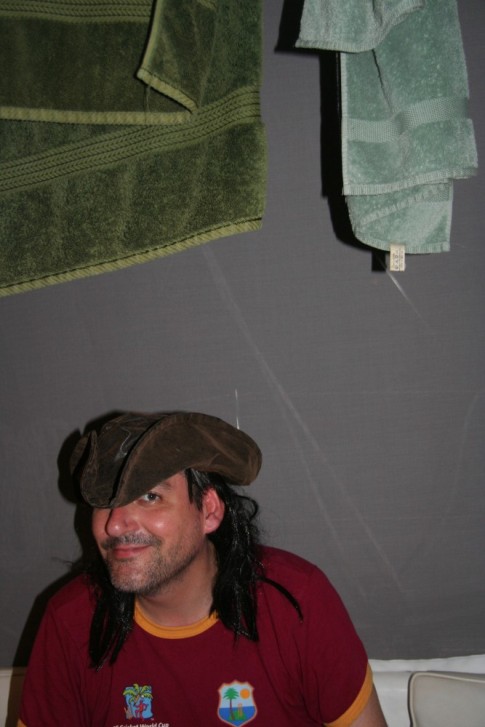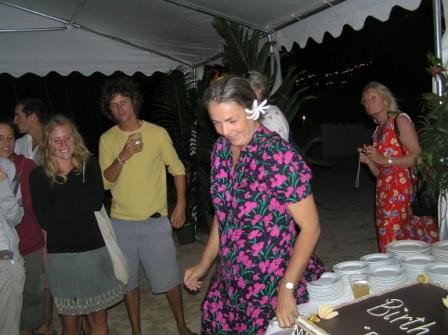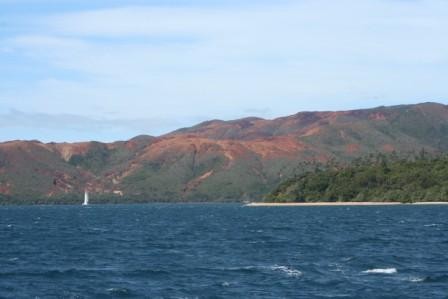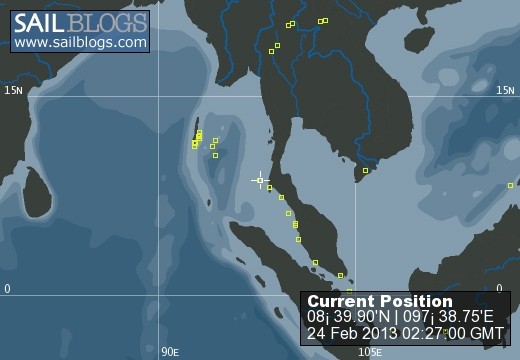
Around the World
23 February 2013 | Similan Islands Thailand
21 February 2013 | Bay of Bengal
15 February 2013 | Cinque Islands
15 February 2013 | Henry Lawrence Island
12 February 2013 | North Button Island
10 February 2013 | Henry Lawrence Island
09 February 2013 | Havelock Island
06 February 2013 | Neil Island
04 February 2013 | Rutland Island
01 February 2013 | Andaman Sea
30 January 2013 | Port Blair
26 January 2013 | Andaman Sea
26 January 2013 | Andaman Sea
03 December 2012 | Burma
02 December 2012
08 November 2012
08 November 2012 | Thailand
08 November 2012
10 June 2012 | Rebak Marina Langkawi
06 February 2012 | Malaysia
Oyster Island Resort
11 August 2009 | Oyster Island Vanuatu
Michael and Jackie
If you have Google Earth you should get a good view of our current location. We arrived in the morning so that we could find our way in easily through the reefs and sandbars. Oyster Island is just north of Luganville, the main town in Espiritu Santo. Because we are part of the ICA rally we were able to check in here rather than having to anchor off Luganville itself. The situation is delightful. The anchorage is behind the island and you enter by crossing a series of sandbars which monohulls can only cross at high tide. Once inside you are anchored in a perfect combination of good holding, sheltered water, cooling breeze and access to a delightful resort and beach bar. The island has some wrecks of fighter planes around it which can be snorkeled on . The swimming is particularly interesting because the water forms two layers. A cooler fresh water layer from the nearby rivers, lying over a very warm salt water layer.
The resort is owned by one of the couples on the rally so it is particularly boat friendly. The food is excellent as is the wine which comes from their own vineyard in the Bay of Islands. There is a dinghy service which links the island to the mainland and from there you can get taxis into town etc. We first of all headed into town to stock up on provisions. The road is unmetalled so the journey is quite jerky. There is a project to metal it in progress at the moment so I imagine that next year the journey will be a lot easier on aching bodies.
The town of Luganville, is unprepossessing, unlike Port Vila which is quite attractive. Little has changed to the buildings since the Americans left. Although British and French ruled here through the Condominium the American heritage is the most evident. There are few oddities eg Luganville had two adjacent police stations, one French and one English. French is the second language here, after Bislama, the Pidgin English used throughout Vanuatu. The town is one dusty or muddy strip, depending on the weather with numerous Chinese stores selling much the same thing, lots of imported clothes. There are also a lot of shops specialising in the sharp machetes essential for all agriculture here.
The landscape is less obviously tropical than Fiji and Tonga partly because of the ravages of logging, and partly because of the extensive cattle grazing. Vanuatu beef is particularly fine, and many of the farms are owned by Japanese with the bulk of the product being exported to Japan.
Vanuatans are particularly fond of kava, and the roadside abounds with kava huts where people relax from 4.30 onwards, and sometimes earlier. We were told by the locals that women now drink kava, and more so than men. Kava we were told is cheaper than white man' drinks - beer etc plus it just relaxes you so that there is no need to worry about things. Alcohol though makes people aggressive.
The resort's other owner, Grant has lived here much of his life and organised a trip for us to a local village. The village was in the heart of the island so it involved many miles of rough roads to get there. The scenery of the island is mainly overgrown bush adjacent to extensive grazing land. The road, probably originally military was mostly straight with farmland to the left, originally developed by Grant's father and bush to the right. The bush was peppered with small traditional villages. The villages tend to have thatched roofs and rush walls made from pandanas leaves. Around each village there are extensive garden areas. In Tanna we had visited a Kastom village who were used to tourists and put on a bit of a show. This village was just an ordinary one going about its business. This village is a satellite village of a larger village elsewhere and the chief is currently living in the other village. When tribes get too big, some people start up a satellite village elsewhere. The two parts of the tribe get together for various celebrations. We were greeted by the witch doctor, herbalist, Neville who demonstrated the various herbs he used, including one which would stop malaria and another which would stop someone shooting at you. He is currently teaching his skills to one of his sons who will take over the role from him. He also showed us with great pride his bow and arrow which he used for shooting birds and fruit bats. The arrows were made out of bamboo, with tiny metal barbs he had made out of wire. His ten children and three grandchildren surrounded us posing for photos and demonstrating their skills with the machetes. Age is rather a vague thing and children are referred to as pikininis, ten plus, fifteen plus etc. and when you get to fortyish you are referred to as an old fellow.
The village consisted of a series of huts surrounding an open central area the size of a football field on which the children slithered in the mud and played. The rain was pretty heavy. Armed with banana leaves as umbrellas we toured the gardens with Grant translating from Bislama. The village has a water supply from a standpipe. We noticed electricity meters at the entrance. These were put in as a condition for cables from a hydro electric scheme passing through the village. However,no one can afford the charges so none of the huts have electricity. The villagers subsist on what they grow in the fertile soil and sell their surplus to market. They refer to their lifestyle as Kastom since it is an assertion of their traditional way of living and system of beliefs. MOst people in Vanuatu live in such villages and speak their own tribe languages as well as French and Bislama.
The resort is owned by one of the couples on the rally so it is particularly boat friendly. The food is excellent as is the wine which comes from their own vineyard in the Bay of Islands. There is a dinghy service which links the island to the mainland and from there you can get taxis into town etc. We first of all headed into town to stock up on provisions. The road is unmetalled so the journey is quite jerky. There is a project to metal it in progress at the moment so I imagine that next year the journey will be a lot easier on aching bodies.
The town of Luganville, is unprepossessing, unlike Port Vila which is quite attractive. Little has changed to the buildings since the Americans left. Although British and French ruled here through the Condominium the American heritage is the most evident. There are few oddities eg Luganville had two adjacent police stations, one French and one English. French is the second language here, after Bislama, the Pidgin English used throughout Vanuatu. The town is one dusty or muddy strip, depending on the weather with numerous Chinese stores selling much the same thing, lots of imported clothes. There are also a lot of shops specialising in the sharp machetes essential for all agriculture here.
The landscape is less obviously tropical than Fiji and Tonga partly because of the ravages of logging, and partly because of the extensive cattle grazing. Vanuatu beef is particularly fine, and many of the farms are owned by Japanese with the bulk of the product being exported to Japan.
Vanuatans are particularly fond of kava, and the roadside abounds with kava huts where people relax from 4.30 onwards, and sometimes earlier. We were told by the locals that women now drink kava, and more so than men. Kava we were told is cheaper than white man' drinks - beer etc plus it just relaxes you so that there is no need to worry about things. Alcohol though makes people aggressive.
The resort's other owner, Grant has lived here much of his life and organised a trip for us to a local village. The village was in the heart of the island so it involved many miles of rough roads to get there. The scenery of the island is mainly overgrown bush adjacent to extensive grazing land. The road, probably originally military was mostly straight with farmland to the left, originally developed by Grant's father and bush to the right. The bush was peppered with small traditional villages. The villages tend to have thatched roofs and rush walls made from pandanas leaves. Around each village there are extensive garden areas. In Tanna we had visited a Kastom village who were used to tourists and put on a bit of a show. This village was just an ordinary one going about its business. This village is a satellite village of a larger village elsewhere and the chief is currently living in the other village. When tribes get too big, some people start up a satellite village elsewhere. The two parts of the tribe get together for various celebrations. We were greeted by the witch doctor, herbalist, Neville who demonstrated the various herbs he used, including one which would stop malaria and another which would stop someone shooting at you. He is currently teaching his skills to one of his sons who will take over the role from him. He also showed us with great pride his bow and arrow which he used for shooting birds and fruit bats. The arrows were made out of bamboo, with tiny metal barbs he had made out of wire. His ten children and three grandchildren surrounded us posing for photos and demonstrating their skills with the machetes. Age is rather a vague thing and children are referred to as pikininis, ten plus, fifteen plus etc. and when you get to fortyish you are referred to as an old fellow.
The village consisted of a series of huts surrounding an open central area the size of a football field on which the children slithered in the mud and played. The rain was pretty heavy. Armed with banana leaves as umbrellas we toured the gardens with Grant translating from Bislama. The village has a water supply from a standpipe. We noticed electricity meters at the entrance. These were put in as a condition for cables from a hydro electric scheme passing through the village. However,no one can afford the charges so none of the huts have electricity. The villagers subsist on what they grow in the fertile soil and sell their surplus to market. They refer to their lifestyle as Kastom since it is an assertion of their traditional way of living and system of beliefs. MOst people in Vanuatu live in such villages and speak their own tribe languages as well as French and Bislama.
Comments
| Vessel Name: | Lady Kay |
| Vessel Make/Model: | Lagoon 380 |
| Hailing Port: | Falmouth |
| Crew: | Michael & Jackie Chapman |
Blue Waters
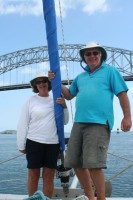
Who: Michael & Jackie Chapman
Port: Falmouth

